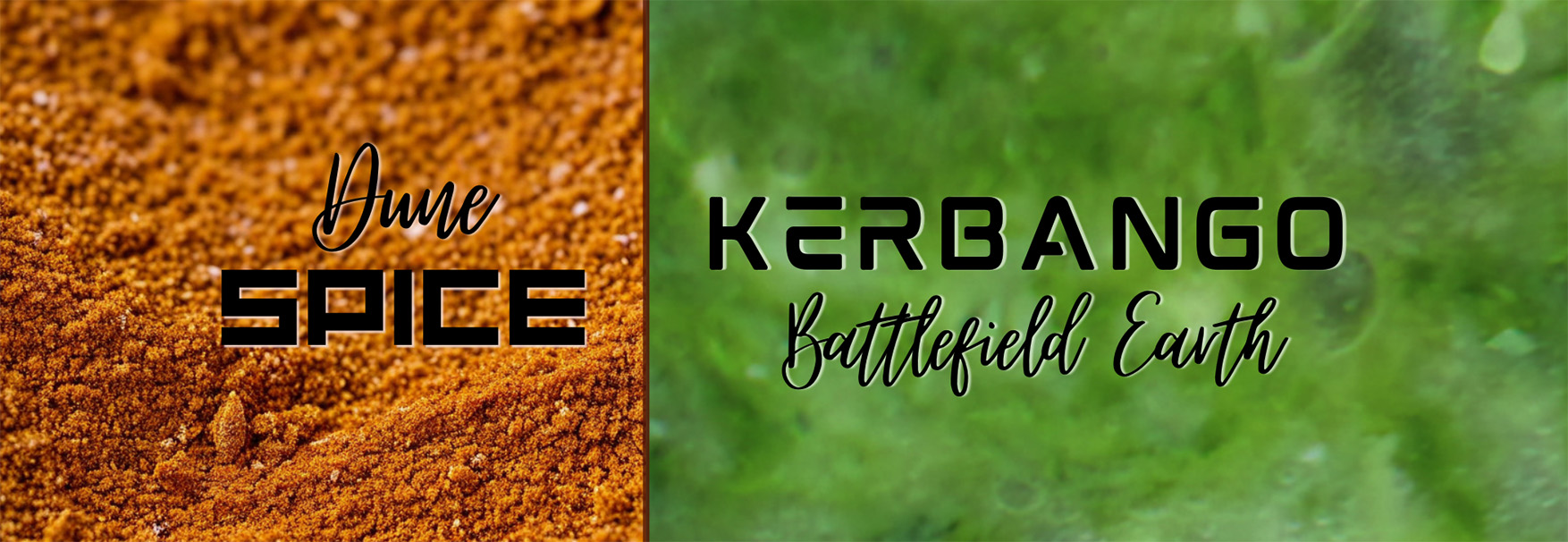Exploring Fictional Drugs in Science Fiction Literature: From Spice to Kerbango
In science fiction literature, authors often introduce fictional drugs—substances that promise transcendence but deliver ruin. These sci-fi drugs serve as allegories, highlighting the perils of addiction and its impact on civilizations.
Before we proceed: this is not a celebration of drug culture. Far from it. It is a warning of addiction’s power to seduce, dominate, and ultimately destroy.
From the spice of Dune that bends time and space, to the green Kerbango in Battlefield Earth that contributed to the fall of an empire, these imagined chemicals are as much a death knell as a dream.
Here’s a look at the strange and fatal world of drugs in sci-fi.
Battlefield Earth by L. Ron Hubbard
Drug: Kerbango
Form: Liquid and semi-solid (green and oily)
Description: Kerbango is a potent Psychlo stimulant that produces effects similar to alcohol—except it also helps Psychlos fall asleep.
Fallout: The Psychlos’ addiction to and dependence on Kerbango made them careless and vulnerable, accelerating their eventual defeat and downfall at human hands.
Dune by Frank Herbert
Drug: Melange (the spice)
Form: Edible and inhaled (powdered spice)
Description: The spice of Arrakis glows faintly, has narcotic properties, smells of cinnamon, and grants expanded consciousness, prescience, and elongated life—at a terrible cost. An individual’s addiction to the spice deepens with continued use. Fallout: Dependence on spice shapes and corrupts the universe’s economy, religion, and politics, leading to violent wars and the collapse of civilizations.
Neuromancer by William Gibson
Drug: Beta-phenethylamine derivatives (various designer drugs)
Form: Injectable and consumable
Description: Case, the ex-hacker protagonist, is maimed to prevent him from accessing cyberspace after drug abuse burns out his nervous system.
Fallout: Drugs hollow out identity, symbolizing the broader decay of human freedom under a corporate-dominated cyberpunk society.
The Stars My Destination by Alfred Bester
Drug: PyrE (chemical explosive responsive to telepathy)
Form: Powder
Description: PyrE detonates with psychic intent—destruction itself becomes addictive.
Fallout: PyrE’s psychic lure mirrors substance addiction, igniting violent revolutions and symbolizing how unrestrained power destroys entire societies.
Brave New World by Aldous Huxley
Drug: Soma
Form: Pill and vapor
Description: Soma provides emotional anesthesia, smoothing out every pain or passion. Citizens float in chemically maintained bliss, devoid of real feeling.
Fallout: An entire civilization sacrifices freedom, individuality, and humanity in exchange for permanent chemical pacification.
A Scanner Darkly by Philip K. Dick
Drug: Substance D
Form: Pill or injectable
Description: Substance D splits the mind into warring halves, eroding personal identity until nothing remains.
Fallout: Addiction to Substance D symbolizes the collapse of the self, and the state’s inability—or unwillingness—to save its own people.
The Three Stigmata of Palmer Eldritch by Philip K. Dick
Drug: Can-D and Chew-Z
Form: Chewable substances
Description: Can-D allows space colonists to escape grim reality into a shared hallucination; Chew-Z promises private godhood but at a terrible cost.
Fallout: Users lose the ability to distinguish reality from hallucination, becoming prisoners of their own yearning.
Red Mars by Kim Stanley Robinson
Drug: Quick
Form: Injectable
Description: Quick is a brutal stimulant, allowing colonists to survive the merciless labor demands of terraforming Mars.
Fallout: Overuse burns out bodies and minds, fraying the social fabric and fueling the eventual civil wars that fracture Martian society.
Altered Carbon by Richard K. Morgan
Drug: Stims and Mesh
Form: Pills and injectables
Description: Stims enhance performance; Mesh is a relaxant. In a world where minds outlast bodies, chemical tuning becomes routine.
Fallout: Drug dependence dehumanizes existence even further, stripping life down to programmable performance.
Snow Crash by Neal Stephenson
Drug: Snow Crash
Form: Data-virus and physical drug
Description: Snow Crash infects the mind both digitally and biologically, hacking the brain’s language centers to control thought.
Fallout: Addiction to information itself erodes free will, enslaving individuals in a new kind of digital serfdom.
Star Wars (Expanded Universe)
Drug: Glitterstim
Form: Crystalline substance
Description: Mined from Kessel, Glitterstim grants temporary telepathic powers but is dangerously addictive. Prolonged exposure to light renders it inert.
Fallout: The smuggling and abuse of Glitterstim fuels corruption, organized crime, and galactic instability.
Other Examples from the 60s and 70s
The golden age of speculative fiction preceded many other cautionary tales of addiction and escapism:
- Douglas Adams gave us frood—more a lifestyle than a drug, yet a satirical nod to empty cultural buzz.
- John Brunner’s Stand on Zanzibar featured drugs like Bliss and Boost—chemical companions to dystopian chaos.
- Robert Heinlein’s Stranger in a Strange Land offered intoxicating drinks that blurred emotional lines as much as physical ones.
Each story, whether subtle or not, pointed to the same hard truth: that indulgence without wisdom spells doom.
Warnings from Distant Stars
Whether it’s the addictive lure of immortality or the numbing escape from reality, science fiction’s most destructive substances reveal a universal truth: unchecked craving doesn’t just destroy individuals—it topples civilizations. Entire worlds fall. Whole species, entire alien races, forget who they are.
“Unchecked craving doesn’t just destroy individuals—it topples civilizations.”
While these drugs are presented as fictional creations, their echoes are frighteningly real in our everyday lives on Earth. Though not identical in form, many modern substances carry the same aftermath: the promise of transcendence, the price of collapse.
In the end, these fictional drugs serve as more than colorful plot devices—they are cautionary tales. They whisper a timeless warning from every distant star and future age: the greatest dangers often come not from without, but from within.




Leave a Reply
Want to join the discussion?Feel free to contribute!